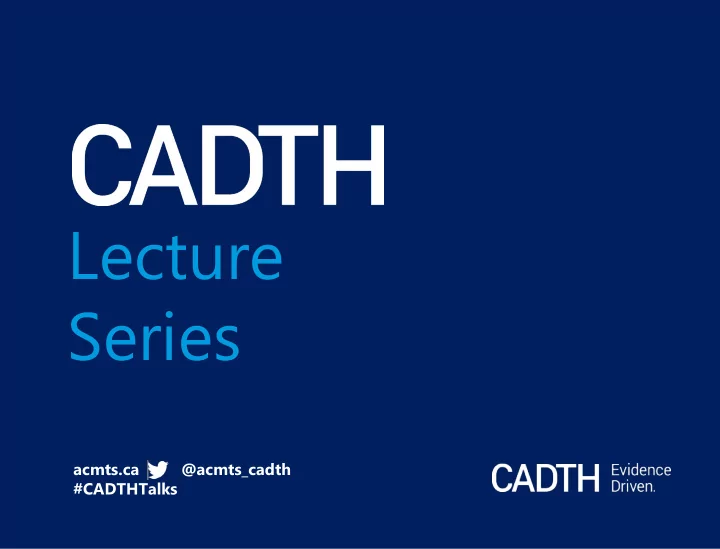

Lecture Series acmts.ca │ @acmts_cadth #CADTHTalks
ALL THAT GLITTERS IS NOT GOLD - ARE SYSTEMATIC REVIEWS Jon Brassey FOOL'S GOLD?
WHERE IT STARTED
ATTRACT Receive question Rapid search Crude appraisal Narrative synthesis
10,000 CLINICAL QUESTIONS Clinicians want easy access to robust answers to their clinical questions = rapid reviews
OUTLINE OF PRESENTATION 1. Problems with current systematic review systems 2. Rapid reviews 3. Trip – some interesting areas of work we’re currently involved in
SYSTEMATIC REVIEW DEFINITION A systematic review is a high-level overview of primary research on a particular research question that tries to identify, select, synthesize and appraise all high quality research evidence relevant to that question in order to answer it. Cochrane Collaboration
UNPUBLISHED TRIALS
UNPUBLISHED TRIALS Schroll JB, Bero L, Gøtzsche PC. Searching for unpublished data for Cochrane reviews: cross sectional study. BMJ. 2013 Apr 23;346
UNPUBLISHED TRIALS • Turner et al. Selective publication of antidepressant trials and its influence on apparent efficacy. NEJM 2008 • Compared outcomes and effect sizes from published trials with those registered with FDA • 31% of FDA-registered studies not published • 37 v 1 – published v unpublished for +ve studies • 3 v 33 - published v unpublished for -ve studies • Overall 32% increase in effect size for meta-analyses of published trials versus FDA
UNPUBLISHED TRIALS • Hart et al. Effect of reporting bias on meta-analyses of drug trials: reanalysis of meta-analyses. BMJ 2011 • 42 meta-analyses for nine drugs across six drug classes were reanalysed • 3/41 (7%) gave identical estimates of effect • 19/41 (46%) showed lower efficacy of the drug • 19/41 (46%) showed greater efficacy of the drug • In ~50% of cases the difference was greater than 10% 50% unreliable
YET MORE DATA • Year on year increase in number of RCTs being carried out • AllTrials initiative • Clinical Study Reports (Nordic Cochrane Centre)
RESOURCE NEEDS TO BE MANAGED Gatekeeper role before large resource expenditure: Outcomes relevant to patients Effect size likely to be clinically significant No forthcoming clinical trials If ‘worthy’ need to decide which method: ‘Standard’ systematic review method More robust Tamiflu style SR based on CSRs or Individual Patient Data (IPD)
RAPID REVIEWS - SEMANTICS Rapid v systematic
RAPID V SYSTEMATIC Time-based? Resource based? Number of databases 5 minutes Bias detection 1 day Level of synthesis 1 week Cost 1 month 1 year Certainly not ‘accuracy’
WHAT IS THE ANSWER? WHAT IS THE QUESTION?
WHY ARE YOU DOING THE REVIEW? 1. Know if intervention A is better than intervention B 2. To quantify how much better A is over B 3. To see what research has been carried out before to avoid waste 4. Assess for adverse events
RAPID REVIEWS ARE PROBLEMATIC • Semantics • Diversity of methods • Little evidence base to guide methods • No obvious rapid review intellectual core • Sometime poor perception
WHAT TO DO? • Coordination • Develop an intellectual core to guide development • Develop robust, transparent methods • Develop a clear narrative
MY INVOLVEMENT IN RAPID REVIEWS • 4 hour manual rapid review • Random selection of Cochrane systematic reviews • Quick search of PubMed Clinical Queries • Abstracts not appraised simply scored +2 = positive and significant +1 = positive 0 = no clear benefit -1 = negative - 2 = negative and significant • 85% agreement with Cochrane systematic reviews
WHAT ABOUT 5 MINUTE REVIEWS? • Mirrored the previous approach but semi-automated it • Used machine learning/sentiment analysis to learn what was a positive study and what was negative • Also used machine reading to identify study size and adjusted the score accordingly • Result = average score • 85% agreement with Cochrane reviews
AUTOMATION – OTHER GROUPS • Paul Glasziou ‘The automation of systematic reviews’, BMJ 2013 Citation analysis/matching • EPPI Centre Machine-learning assisted screening process • Many others : Auto-detection of effect sizes Auto assessment for bias • Typically follow the systematic review methods/principles • All problematic
MACHINE LEARNING – CURRENTLY LIMITED Allan Hanbury, Vienna University of Technology and lead for KConnect “this is rather difficult”
MOVING FORWARD • EU Funded via Horizon 2020 • Improved methods including head-to-head trials • Relatedness – ‘auto aggregate’ new studies with existing reviews • Machine reading and semantic annotation of CSRs • Multilingual
CLICKSTREAM DATA • A user searches and clicks on documents 1, 4 and 5 • We say, for that user’s intention , they are connected • By aggregating these connections we can map the medical literature • Structure is rich and relatively untapped
WHERE TRIP IS HEADING • Personalised results • Instant answers • ‘ Sensemaking ’ of results • Community to seek answers • Sound business model
THE FUTURE Exciting Both for Rapid Reviews and Trip
IN CONCLUSION • Current methods for evidence synthesis are flawed • Needs innovation and reflection • Rapid reviews are a necessity • There needs to be a coherent rapid review position including nomenclature • Automation will be a huge help • Trip hopes to play a leading role
Lecture Series acmts.ca │ @acmts_cadth #CADTHTalks
Recommend
More recommend